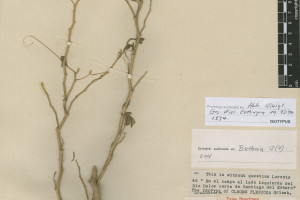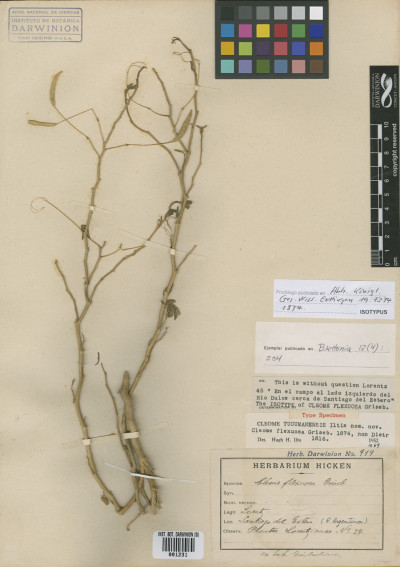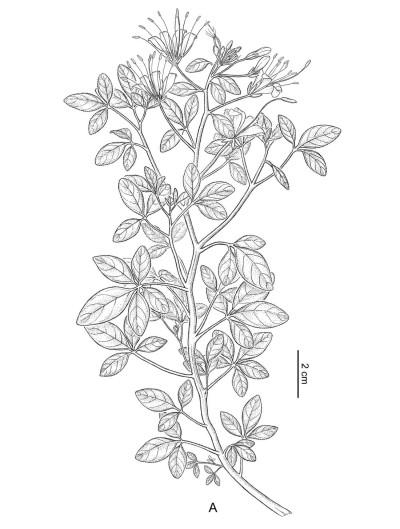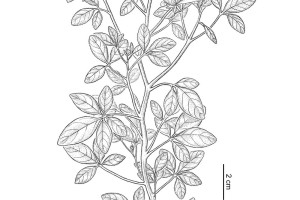Descripcion
Subarbustos de 0,8-1 m de alto; ramas glandular-puberulentas a glabrescentes. Hojas con pecíolos de 2,5-4 cm de largo, inermes, puberulentos; espinas estipulares de 1-2 × 1 mm, rectas, que faltan en algunos individuos; láminas 3-5 folioladas; peciólulos de 2-4 mm de largo inermes, puberulentos; folíolos ovados a elípticos u oblanceolados, de 1,8-5 × 1-2 cm, basalmente cuneados u obtusos, apicalmente agudos, apiculados, ambas caras glabras, nervadura central y venas secundarias glabras, ciliadas, sin espinas. Inflorescencia en racimos corimbiformes, de 20-30 cm de largo, terminales; brácteas con pecíolos de 2-3 mm de largo, puberulentos y lámina ovada a elíptica, de 15-23 × 5-7 mm, basalmente obtusa o cuneada, apicalmente aguda, apiculada, puberulentas en ambas caras, ciliadas. Flores con pedicelos de 15-25 mm de largo, densamente puberulentos; sépalos triangulares a lanceolados, de 4-5 × 1 mm, acuminados, dorso densamente puberulento, ciliados; pétalos obovados a ampliamente obovados, de 6-8 × 3-4 mm, basalmente contraídos en una garra de 6-8 mm de largo, apicalmente obtusos, glabros, blancos; nectario cónico, carnoso, discreto, obsoleto en el fruto; filamentos estaminales de 20-35 mm de largo, violáceos, anteras 4-5 mm de largo; ovario elipsoide, de 2 mm de largo, glabro; estilo ausente, estigma discoide, sésil. Frutos fusiformes a oblongos, de 3-3,5 × 0,3-0,7 cm, glabros; ginóforo de 30-40 mm de largo. Semillas suborbiculares, de 2,5-3 × 3 mm, longitudinalmente estriadas con crestas transversales agudas, hendiduras anchas, cubiertas por un arilo opaco que conecta las garras.
Distribucion y Habitat
Especie que crece en la Argentina, Bolivia y Paraguay, entre los 0-350 m s.m., en bosques de la Región Chaqueña, en las laderas de colinas bajas, malezas abiertas o sombreadas, en dunas arenosas, áreas urbanas perturbadas y bordes de carreteras. Esta especie está mejor distribuida en el norte de la Argentina, principalmente en la vegetación asociada a la Región Chaqueña.
Sinónimos
Tarenaya tucumanensis (H.H. Iltis) Arana & Oggero
Bibliografía
Ejemplares de referencia
| Colector | N° Colect. | Especie | Departamento | Provincia | Imagen |
|---|---|---|---|---|---|
|
|
1592 | Copo | Santiago del Estero |

|
|
|
|
3381 | Patiño | Formosa |

|
|
|
|
4171 | Formosa | Formosa |

|
|
|
|
6639 | General Güemes | Chaco |

|
|
|
|
798 | Boquerón |

|
||
|
|
21578 | Banda | Santiago del Estero |

|
|
|
|
21778 | Banda | Santiago del Estero |

|
|
|
|
45 | Santiago del Estero |

|
||
|
|
45 | Santiago del Estero | |||
|
|
45 | Santiago del Estero |

|
||
|
|
45 | Santiago del Estero | |||
|
|
4417 | Hernando Siles | Chuquisaca |

|
|
|
|
1261 | Anta | Salta |

|
|
|
|
10956 | Dr. Manuel Belgrano | Jujuy |

|
|
|
|
4024 | (SI 207963) | Santa Victoria | Salta |

|
|
|
667 | General José de San Martín | Salta |

|
|
|
|
654 | Leales | Tucumán |

|
Nombre Vulgar y Usos
Tipo y Observaciones
Material Tipo: Basónimo: Cleome tucumanensis H.H. Iltis
Observaciones: Nombre vernáculo. “Albahaca del monte”.


.mid.jpg)
.mid.jpg)
.mid.jpg)
.mid.jpg)
.mid.jpg)
.mid.jpg)
.mid.jpg)

.thumb.jpg)
.thumb.jpg)
.thumb.jpg)
.thumb.jpg)
.thumb.jpg)
.thumb.jpg)
.thumb.jpg)
